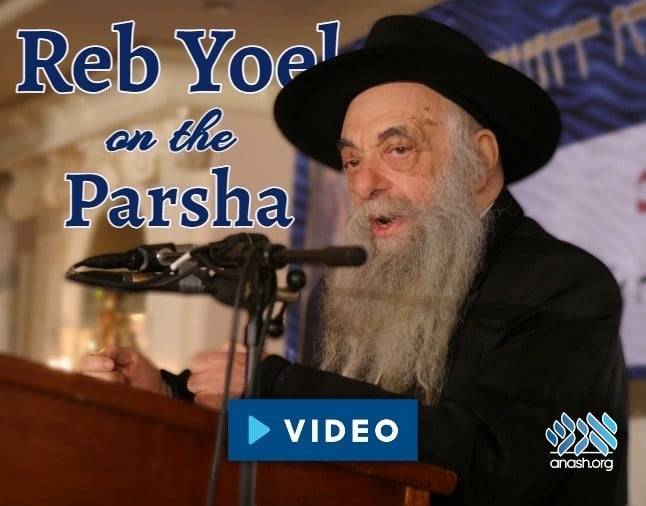כ״ו אלול ה׳תשפ״ב | September 22, 2022
Watch: Reb Yoel on Parshas Nitzavim
Watch: A short lesson by Reb Yoel Kahn on Parshas Nitzavim with an English transcript.

Watch: A short lesson by Reb Yoel Kahn on Parshas Nitzavim with an English transcript.
Watch a short lesson by Reb Yoel Kahn on Parshas Nitzavim with an English transcript.
Scroll down for the English transcript.
VIDEO:
TRANSCRIPT:
The parsha of Nitzavim, unlike Va’yeilech, always immediately precedes Rosh Ha’shana. The Baal Shem Tov also noted that the customary ceremony wherein we bless the upcoming month (“mevarchim”) is absent before Tishrei, and Hashem issues blessings Himself instead, thereby giving us the ability to bless all of the other months in turn. It therefore follows that “nitzavim” is that very blessing itself, in the sense that we stand victoriously, “hayom,” on the day of Rosh Ha’shana.
The pasuk’s simple meaning, however, is that the Jewish people stood for the covenant in which they became “areivim,” responsible for each other. Finally, the Alter Rebbe explains the words to mean that we stand as one, as a single entity. Considering the principle that every alternate explanation for the same text is connected, that must hold true for “nitzavim” as associated with blessing, mutual responsibility and unity as well.
Who Guarantees Whom?
When we scrutinize our ‘arvus’ in light of the plain connotation of the term (guaranteeing a loan), it becomes obvious that the ideal profile of a real-life guarantor is an individual who is in a greater position to repay the loan than the borrower. Why then does our spiritual ‘arvus’ (in the sense that we can utter a bracha before being motzi someone else’s mitzvah obligation, for instance) not require a Jew of greater stature to cover for his lesser fellow, instead allowing everyone equal powers?
The Alter Rebbe’s answer is: We are in fact all part of a singular being. Every physical limb has its advantage, and though the head may be higher than the feet, the feet can walk while the head can’t. In fact, if we define “head” as a body’s source of energy, we can argue that the feet are the head’s “head” where walking is concerned. Likewise, every Jew has his unique advantage, an area where everyone else acknowledges his superiority, and that is why as a spiritual arev, a simple man being motzi a tzadik actually does possess the more favorable dynamic.
One Essence
The Baal Shem Tov, however, interpreted ‘areivim’ in the sense of mixing (aside from also being related to the Hebrew word for sweetness). The Alter Rebbe himself employs two different wordings: That we all need each other, and that we’re all one. The former still implies separateness, while the latter is a deeper perspective in which just as all of the bodies’ limbs come together as a perfect, undivided whole, we too belong to a singular klal, beyond any of the particulars which make us individually important.
When the parts of the menora were fashioned from a single bar of gold, there were distinct sections, but none could be said to be ‘top’ or ‘bottom.’ This teaches us that ‘different but equally important’ is itself predicated on total oneness; when something is singular on the inside, then its parts retain the quality of complementing each other even upon branching out. This is similarly the case with “nitzavim,” where because we’re all essentially one, then even when we appear to be divided by class (from “your heads” to “those who draw your water”) we still have something to offer each other.
A Reciprocal Society
Ultimately, which phase is greater? On the one hand, being one with the whole represents perfection, but ultimately, the goal is to have ahavas Yisroel. We may originally be one, but there’s no point of just staying in shul and focusing on that, to the exclusion of everything else! The point is for the ‘gold to take shape,’ for the underlying oneness to translate into a reciprocal society, not ignoring worldly divisiveness, but tackling it and literally assisting each other on the basis of our true unified nature.
The Rebbe notes that the covenant of ‘areivim’ under discussion took place immediately before leaving the desert for Eretz Yisroel, but it only went into force after they entered the land. This raises a question: Why didn’t it take effect immediately, or conversely, why couldn’t the entire event wait until the Jewish people actually crossed the border with Yehoshua.
The answer lies in the fact that the desert represents a state of spirituality stripped of materialism, whereas everyone received his own individual portion of the land of Eretz Yisroel to farm and till. The state we desire is one in which ‘arvus’ represents being separate yet ‘mixed,’ Eretz Yisroel, but that must be preceded by the covenant in the desert in which we all stood as one.
How the three aspects of “nitzavim” come together is now evident: When there’s mutual ‘responsibility’ among distinct entities because we ultimately start out as ‘one,’ we thus merit the ‘blessings’ of a sweet new year, as per the Baal Shem Tov’s explanation. And ‘arvus,’ the ‘sweet’ behavior which is the expression of the ‘responsibility’ we enjoy as a result of being ‘mixed,’ is thus the perfect vessel for “nitzavim” as a blessing to stand victoriously in judgment this Rosh Ha’shana.
For further learning see לקוטי שיחות חלק ד’ פרשת נצבים.


We appreciate your feedback. If you have any additional information to contribute to this article, it will be added below.